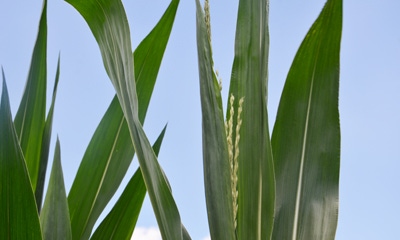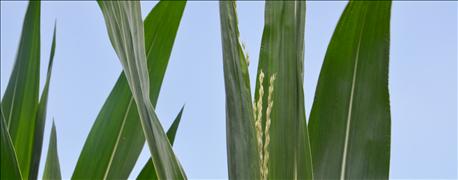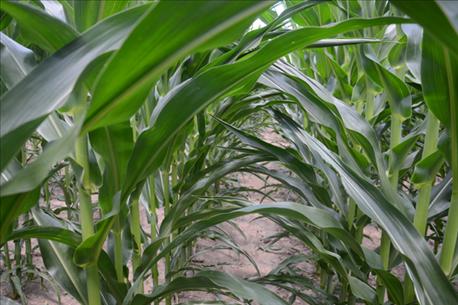
One year ago by this time, there was lots of chatter about disease across most of the east-central Corn Belt. There are some reports this year, especially of northern corn leaf blight in some areas. But based on the Crop Watch ’16 field, located on the same farm and a mile away from last year's location, the striking difference so far is the lack of disease lesions. A trip through the field just a few days ago, walking through corn that is tasseling by now, failed to turn up even a single lesion. That wasn’t the case a year ago.
The time to make fungicide decisions is here for many fields, and coming soon for late-planted fields. Here are two key points related to that process.

TASSELING UNDERWAY: When the first tassel emerges, the others aren’t far behind. Here’s a shot of one of the first tassels peeking out in the Crop Watch field recently. Notice leaves are clean — no lesions.
1. Keep scouting, whether you have seen lesions or not.
Dave Nanda, crops consultant for Seed Consultants Inc., sponsor of Crop Watch ’16, believes whether or not there are disease lesions in the field is important in deciding whether or not to apply a fungicide. Even though a walk through this year’s field a few days ago showed no lesions, it’s important to keep scouting regularly during this crucial period, he notes.
Diseases can develop quickly if conditions are right. However, the lack of disease lesions near this point in the season indicates that so far, disease pressure is light.
It’s also important to know the disease ratings for each hybrid, he says. If you do begin to find lesions, are there more on some hybrids than others? If fungicide is needed, perhaps it’s only needed on the most susceptible hybrids.
2. Refresh yourself on what disease lesions look like.

CLEAN AND GREEN: Near midseason, the Crop Watch field is clean and green. The first lesion is yet to be detected. That’s in stark contrast to one year ago.
Look up visual symptoms of northern corn leaf blight and gray leaf spot in the Purdue University Corn & Soybean Field Guide. They are two of the most common foliar diseases in this part of the world.
Also note that if you find even one lesion, make sure you monitor that field closely, Nanda says. In this photo (left) from one year ago in the Crop Watch field, the situation went from a few single lesions like this one to leaves having a considerable number of lesions, even on the ear leaf and above, rather quickly. Also, 10 or more inches of rain fell during late June through late July a year ago in many areas, including the Crop Watch field. Plenty of moisture and humidity favor many diseases, Nanda concludes.
About the Author(s)
You May Also Like




